Annotated Publications for James K. Freericks
Review Articles
- J. K. Freericks
and V. Zlatic',
Exact dynamical mean field theory of the Falicov-Kimball model,
Rev. Mod. Phys. 75, 1333--1382 (2003).
A comprehensive review of equilibrium properties of the Falicov-Kimball
model, solved with dynamical mean field theory. The formalism is developed
from a path-integral approach.
- J. K. Freericks,
B. K. Nikolic,
and P. Miller,
Optimizing the speed of a Josephson junction with dynamical mean-field theory,
Int. J. Mod. Phys. B 16, 531--561 (2002).
A review of the application of the local approximation and the
Falicov-Kimball model to the theory of Josephson junctions with barriers
tuned near the metal-insulator transition.
-
V. Zlatic',
J. K. Freericks,
R. Lemanski, and
G. Czycholl,
Exact solution of the multi-component Falicov-Kimball model in infinite
dimensions, Phil. Mag. B 81, 1443 (2001).
A mini review of the Falicov-Kimball model that emphasizes an equation
of motion approach. Properties of both conduction and localized electrons
are included as well as a discussion of spontaneous hybridization.
-
Th. Pruschke,
M. Jarrell,
and J. K. Freericks,
Anomalous Normal-State Properties of High-Tc Superconductors --
Intrinsic Properties of Strongly Correlated Electron Systems?, Adv. Phys.
44 187--210 (1995).
A short review of dynamical mean field theory for the Hubbard model
with an emphasis on transport properties.
-
J. K. Freericks
and M. Jarrell,
Simulation of the electron-phonon
interaction in infinite dimensions, in Computer Simulations in
Condensed Matter Physics VII,
edited by D. P. Landau, K. K. Mon, and H.-B.
Schuttler (Springer-Verlag, Heidelberg, Berlin, 1994).
A short review of the numerical techniques for performing quantum
Monte carlo simulations of the electron-phonon problem in infinite
dimensions.
Josephson Junctions
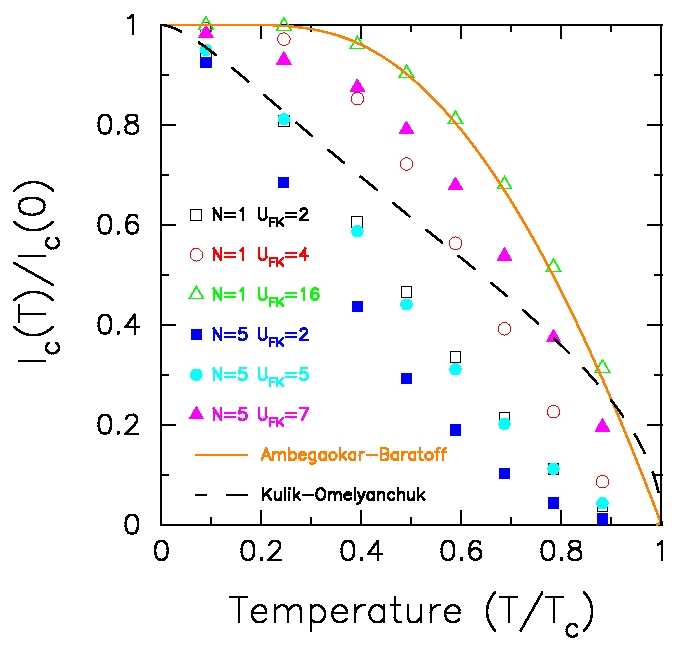
-
B. K. Nikolic,
J. K. Freericks,
and P. Miller,
Reduction of Josephson critical current in short ballistic SNS weak
links, Phys. Rev. B 64, 212507--1-4 (2001).
B. K. Nikolic,
J. K. Freericks,
and P. Miller,
Suppression of the ``quasiclassical'' proximity gap in
correlated-metal--superconductor structures,
Phys. Rev. Lett. 88, 077002-1--4 (2002);
Virtual Journal of Nanoscale Science & Technology, Vol. 5,
Iss. 7.
B. K. Nikolic,
J. K. Freericks,
and P. Miller,
Equilibrium properties of double-screened-dipole-barrier SINIS Josephson
junctions, Phys. Rev. B 65, 064529-1--11 (2002);
Virtual Journal of Applications of Superconductivity, Vol. 2,
Iss. 3.
P. Miller and
J. K. Freericks,
Microscopic self-consistent theory of
Josephson junctions including dynamical electron correlations,
J. Phys.: Conden. Mat. 13 3187--3213 (2001)
In this series of papers, we generalize dynamical mean field theory to solve
inhomogeneous systems in the superconducting phase. We discover
a number of new results that arise from the self-consistent description
of a Josephson junction including (i) the proposal that SNSNS structures with
a narrow S layer within the normal metal barrier can have dramatically
improved characteristic voltages; (ii) the suppresion of the quasiclassical
minigap due to electron correlations; (iii) the reduction of characteristic
voltage due to Schottky-like charge rearrangements at the superconductor-normal
metal interface; and (iv) a reduction of the characteristic voltage
due to the proximity and inverse proximity effects in ballistic junctions.
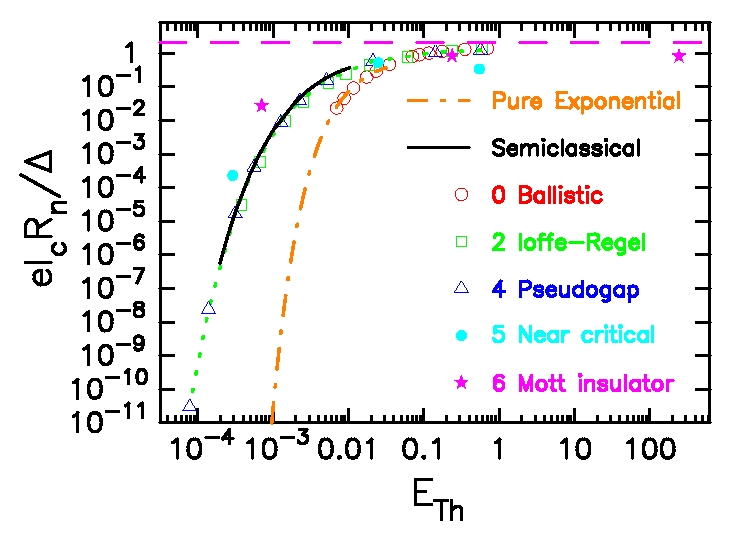
-
J. K. Freericks,
B. K. Nikolic,
and P. Miller,
Superconductor-Correlated Metal-Superconductor
Josephson junctions: an optimized class for high speed digital electronics,
(Proceedings of the Applied Superconductivity Conference, Houston, Texas)
IEEE Trans. Appl. Supercond. 13, 1089 (2003).
J. K. Freericks,
B. K. Nikolic,
and P. Miller,
Temperature dependence of Superconductor-Correlated Metal-Superconductor
Josephson junctions, Appl. Phys. Lett. 82, 970--972 (2003);
Virtual Journal of Applications of Superconductivity, 4, Issue 4
(2003);
Erratum
Appl. Phys. Lett. 83, 1275 (2003).
J. K. Freericks,
B. K. Nikolic,
and P. Miller,
Tuning a Josephson junction through a quantum critical point,
Phys. Rev. B 64, 054511 (2001).
In this series of papers, we concentrate on what happens to a Josephson
junction as the barrier material is tuned from a metal to an insulator.
We find a number of interesting resuts, including the possibility of
having self-shunted junctions that have the fastest switching times.
Superconductivity in real materials
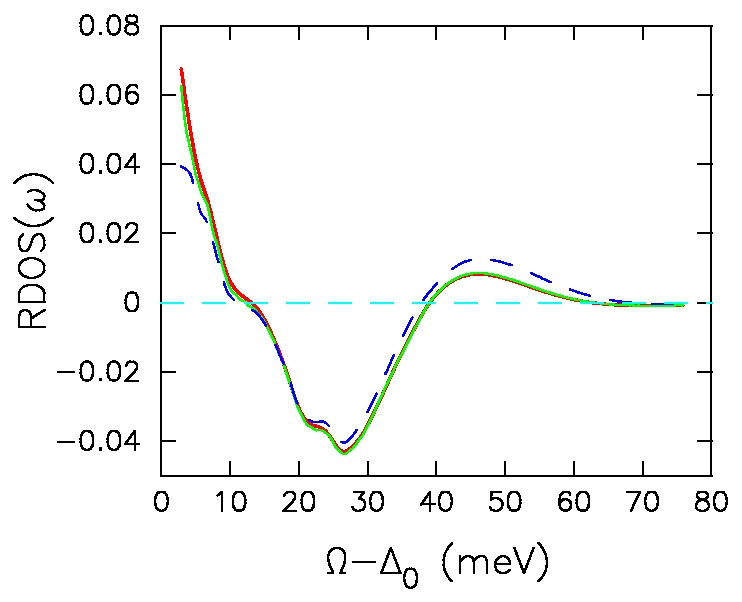
-
J. K. Freericks,
Amy Y. Liu,
A. Quandt,
and J. Geerk,
Nonconstant electronic density of states tunneling inversion for A15
superconductors: Nb3Sn,
Phys. Rev. B 65, 224510--1-10 (2002).
We reexamine the tunneling data for A15 compounds using a tunneling
formalism that incorporates the nonconstant electronic density of states
that is calculated with density functional theory. The sharp peak in
the DOS modifies the tunneling conductance, but it is not enough to
fully explain the so-called "overswing".
-
Sven P. Rudin,
Amy Y. Liu,
J. K. Freericks,
and A. Quandt,
Comparison of structural transformations and superconductivity in
compressed Sulfur and Selenium,
Phys. Rev. B 63, 224107 (2001).
J. K. Freericks,
S. P. Rudin,
and A. Y. Liu,
First-principles determination of superconducting properties of metals,
Physica B 284-288, 425-426 (2000)
This work plots out the phase diagram of chalcogenides under high
pressure. Sulfur becomes the highest temperature elemental
superconductor when it metallizes, but has large changes in Tc as the
pressure tunes it through a series of structural transitions. Selenium
and Tellurium behave in a similar fashion, but never are stabilized in
a simple-cubic phase as Sulfur is.
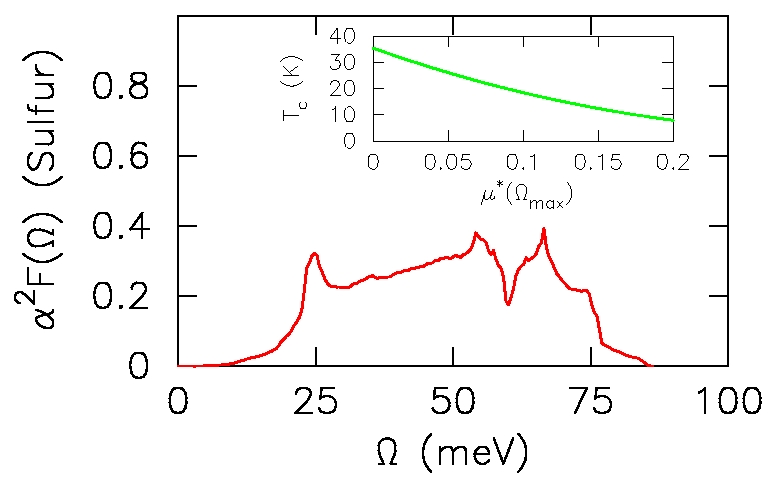
-
A. Y. Liu,,
A. A. Quong,
J. K. Freericks,
E. J. Nicol,
and E. C. Jones,
Structural phase stability and electron-phonon coupling in Lithium,
Phys. Rev. B 59, 4028--4035 (1999).
This paper deals with a long-standing puzzle: why is it that Lithium and
Aluminum have almost the same electron-phonon coupling but Aluminun
superconducts at about 1K, while Lithium is not superconducting down to 0.004K?
We show that the stable low-temperature phase of Lithium (which is determined
by an ``honest'' quasiharmonic analysis) has a smaller
electron-phonon coupling and conventional theory could explain a
superconducting Tc down to about 0.001K beyond which other explanations
would need to be found to resolve the puzzle. Experiments at Berkeley
have not found any sign of superconductivity down to 0.005K, but they
did see a large Curie-like magnetic response, so Lithium may have some
more surprises for us.

-
S. P. Rudin, R. Bauer,
A. Y. Liu, and
J. K. Freericks,
Reevaluating electron-phonon coupling strengths: Indium as a
test case for ab initio and
many-body-theory methods, Phys. Rev. B 58, 14511--14517 (1998).
J. K. Freericks,
E. J. Nicol,
A. Y. Liu,
and A. A. Quong, Vertex-corrected tunneling inversion in superconductors,
Czechoslovak Journal of Physics 46, Supplement S2,
603-604 (1996).
Here we examine how to calculate the tunneling density of states
of Indium using only one adjustable parameter---the Coulomb pseudopotential.
We find that our theoretical results are as accurate as an experimental
fit to the data (better than one part in 10,000), which illustrates that
current theoretical methods can rival those of experiment for low-temperature
superconductors. In the process, we discovered that even though the data
can be fit quite accurately, the value of the electron-phonon coupling may
have errors as high as 20%.
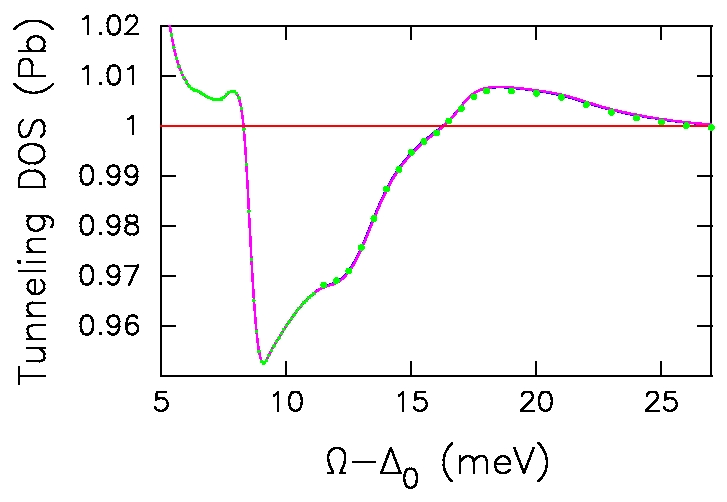
-
J. K. Freericks,
E. J. Nicol,
A. Y. Liu,
and A. A. Quong,
Vertex-corrected tunneling inversion in electron-phonon
mediated superconductors: Pb, Phys. Rev. B, 55,
11651--11658 (1997).
We generalize the conventional Migdal-Eliashberg theory to include
vertex corrections and see if effects of vertex corrections can be seen
in Lead. We find that the effects of the vertex corrections are just on the
edge of being able to be seen in Lead (the difficulty arises from the
very low phonon frequencies in Lead, which suppress vertex correction
effects). This technique can be employed on other materials like
the fullerenes or cubic perovskites, whenever high quality tunneling data
is produced for them.
Raman scattering, optical conductivity, and transport
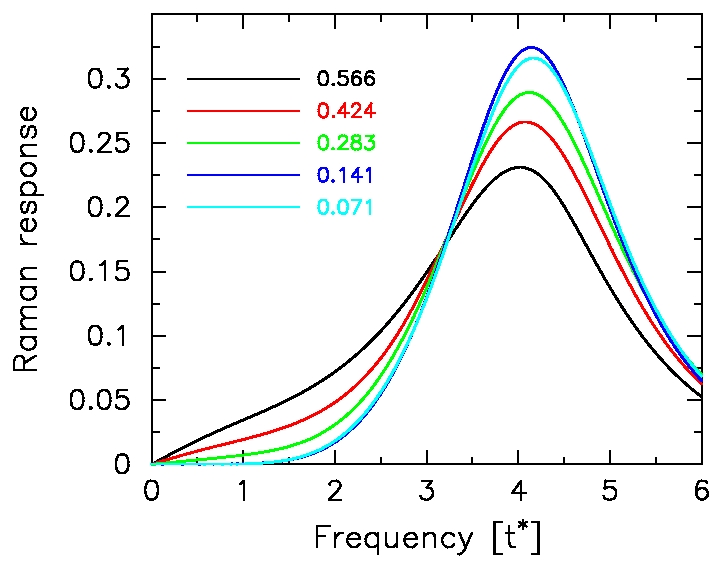
-
J. K. Freericks,
T. P. Devereaux, and
R. Bulla,
Inelastic light scattering and the correlated metal-insulator transition,
(Proceedings of the NATO ARW on strongly correlated electrons, Hvar, Croatia)
Nato Science series II: Mathematics Physics and Chemistry: Vol. 110 (Kluwer,
Dordrecht, 2003), p. 115--122.
J. K. Freericks,
T. P. Devereaux, and
R. Bulla,
Inelastic Light Scattering
and the Correlated metal-Insulator Transition, (Proceedings of the
Strongly Correlated Electrons conference, Krakow, Poland)
Acta Physica Polonica B 34, 737--748 (2003).
J. K. Freericks,
T. P. Devereaux,
R. Bulla,
and
Th. Pruschke,
Nonresonant inelastic light scattering in the Hubbard model,
Phys. Rev. B 67, 155102--1-8 (2003).
F. Venturini, M. Opel,
T. P. Devereaux,
J. K. Freericks, I. Tutto, B. Revaz,
E. Walker, H. Berger, L. Forro, and R. Hackl,
Observation of an unconventional
metal-insulator transition in overdoped CuO2 compounds,
Phys. Rev. Lett. 89, 107003--1-4 (2002).
J. K. Freericks,
T. P. Devereaux, and
R. Bulla,
An exact theory for Raman scattering in correlated metals and
insulators, Phys. Rev. B 64, 233114 (2001).
J. K. Freericks
and T. P. Devereaux,
Raman scattering through a metal-insulator transition,
Phys. Rev. B 64, 125110 (2001).
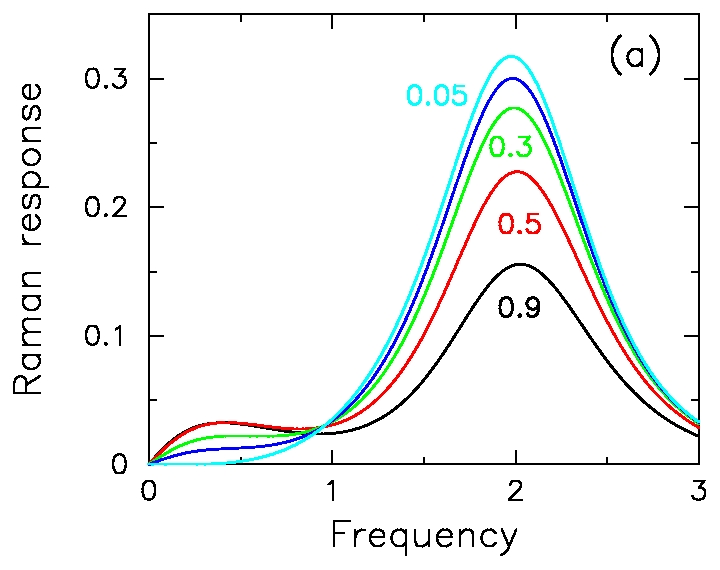 J. K. Freericks,
T. P. Devereaux, and
R. Bulla,
B1g Raman scattering through a quantum critical point,
(Proceedings of the XIIth school of modern physics on
phase transitions and critical phenomena, Ladek Zrdoj, Poland)
Acta Physica Polonica B 32, 3219--3232 (2001).
J. K. Freericks,
T. P. Devereaux, and
R. Bulla,
B1g Raman scattering through a quantum critical point,
(Proceedings of the XIIth school of modern physics on
phase transitions and critical phenomena, Ladek Zrdoj, Poland)
Acta Physica Polonica B 32, 3219--3232 (2001).
J. K. Freericks
and T. P. Devereaux,
Non-resonant
Raman scattering through a metal-insulator transition: an exact analysis
of the Falicov-Kimball model, (Proceedings of the Workshop on Soft Matter
Theory, Lviv, Ukraine) Conden. Matter Phys. (Ukraine) 4, 149--160
(2001).
This is the first work to calculate a Raman response for a system that
undergoes a metal-insulator transition. We find that our results
are universal on the insulating side of the metal-insulator transition
and display the three fundamental features seen in experiment on
strongly correlated materials: (i) a rapid loss of low-energy spectral
weight and a gain of high-energy spectral weight as temperature is
lowered; (ii) the appearance of an isosbestic point, where the Raman
response is independent of temperature at a characteristic frequency;
and (iii) the ratio of the range in frequency over which the Raman
response is depleted at low temperature to the onset temperature where
the depletion begins is large. This behavior has been seen SmB6,
FeSi, and the high-temperature superconductors. The extension of the
nonresonant work to the resonant case represents one of the most
complex solutions to a many-body problem with DMFT.
-
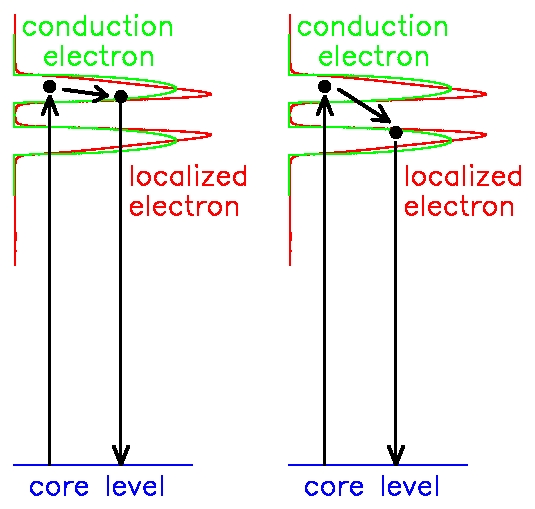 J. K. Freericks,
T. P. Devereaux,
R. Bulla,
and
Th. Pruschke,
Nonresonant inelastic light scattering in the Hubbard model,
Phys. Rev. B 68, 075105--1-11 (2003).
J. K. Freericks,
T. P. Devereaux,
R. Bulla,
and
Th. Pruschke,
Nonresonant inelastic light scattering in the Hubbard model,
Phys. Rev. B 68, 075105--1-11 (2003).
T. P. Devereaux,
G. E. D. McCormack and
J. K. Freericks,
Inelastic x-ray scattering in correlated (Mott) insulators,
Phys. Rev. Lett. 90, 067402--1-4 (2003).
In this work, we focus on the light scattering by X-rays which can exchange
both momentum and energy with the electronic charge excitations of
the correlated material. We see dispersion of some quantities, the
appearance of isosbestic points throughout the Brillouin zone, and a way
to test for the effects of nonlocal charge fluctuations by appropriately
using polarizers. Further extensions will include a description of the
resonant inelastic x-ray scattering process which is an interesting new
experimental technique employed to examine charge excitations of
correlated materials.
-
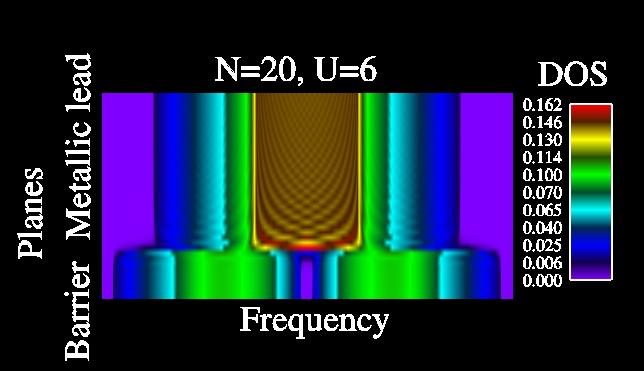 J. K. Freericks,
Crossover from tunneling to incoherent (bulk) transport in a correlated
nanostructure, Appl. Phys. Lett. 84, 1383--1385 (2004);
Virtual Journal of Nanoscale Science and Technology, 9, Issue 8
(2004);
Virtual Journal of Applications of Superconductivity, 6, Issue 5
(2004).
J. K. Freericks,
Crossover from tunneling to incoherent (bulk) transport in a correlated
nanostructure, Appl. Phys. Lett. 84, 1383--1385 (2004);
Virtual Journal of Nanoscale Science and Technology, 9, Issue 8
(2004);
Virtual Journal of Applications of Superconductivity, 6, Issue 5
(2004).
In this work we examine how the transport in a multilayer nanostructure
changes from tunneling (for thin barriers at low temperature) to incoherent
Ohmic transport (for thick barriers at high temperature). We develop the
theory of a generalized Thouless energy that describes the crossover.
- B. K. Nikolic
and J. K. Freericks,
Mesoscopics in spintronics: Quantum interference effects in spin-polarized
electrons, submitted to Phys. Rev. B.
B. K. Nikolic
and J. K. Freericks,
Mesoscopic spintronics: Fluctuation and localization effects in spin-polarized
quantum transport, Toward the controllable quantum states,
edited by H. Takayanagi and J. Nitta (World Scientific, 2003).
Papers on spintronics and the Rashba coupling.
-
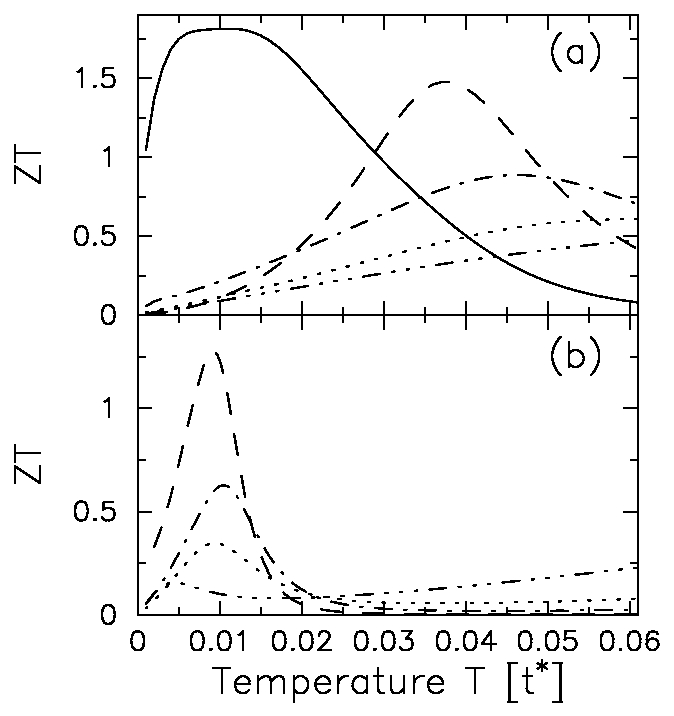 A. V. Joura, D. O. Demchencko, and
J. K. Freericks,
Thermal transport in the Falicov-Kimball model on a Bethe lattice,
Phys. Rev. B 69, 165105--1-5 (2004).
A. V. Joura, D. O. Demchencko, and
J. K. Freericks,
Thermal transport in the Falicov-Kimball model on a Bethe lattice,
Phys. Rev. B 69, 165105--1-5 (2004).
J. K. Freericks,
D. Demchenko, A. Joura,
and V. Zlatic',
Optimizing thermal transport in the Falicov-Kimball model: binary-alloy
picture, Phys. Rev. B 68, 195120--1-12 (2003).
J. K. Freericks
and V. Zlatic',
Thermal transport in the Falicov-Kimball model,
Phys. Rev. B 64, 245118--1-10 (2001);
Erratum: Phys.
Rev. B 66, 249901--1-2 (2002).
Here we examine what happens to thermal transport properties in the
Falicov-Kimball model. We are able to explicitly prove the Jonson-Mahan
theorem and find regions where the thermoelectric figure of merit is
larger than one both at low temperature and high temperature. But it
is likely the low temperature peaks will disappear when phonon thermal
conductivity is included. We also find quite different behavior on the
hypercubic lattice versus the Bethe lattice which is due to anomalous
features associated with the pseudogap nature of the insulating phase
on the hypercubic lattice.
-
B.M. Letfulov and
J. K. Freericks,
Dynamical mean-field theory of a double-exchange model with diagonal
disorder, Phys. Rev. B 64, 174409 (2001).
My only paper on the colossal magnetoresistance materials.
-
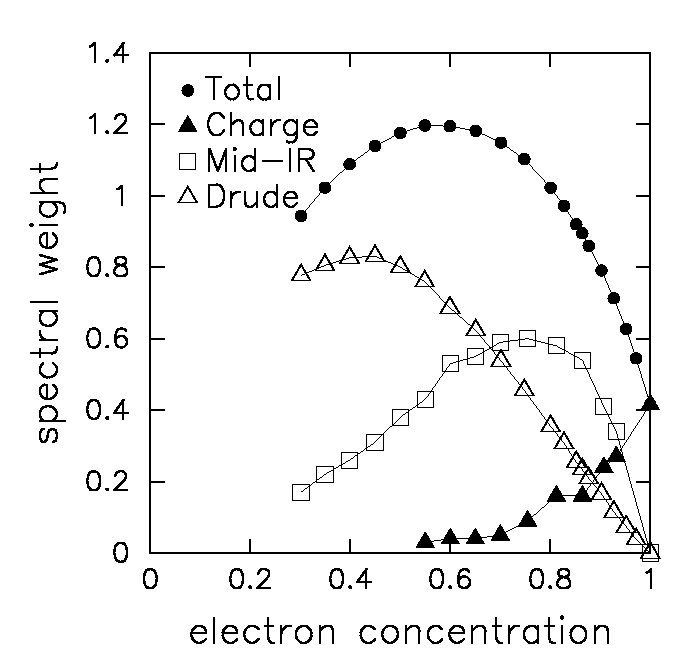 M. Jarrell,
J. K. Freericks,
and Th. Pruschke,
Optical conductivity
of the infinite-dimensional Hubbard model, Phys. Rev. B 51
, 11704-11711 (1995).
M. Jarrell,
J. K. Freericks,
and Th. Pruschke,
Optical conductivity
of the infinite-dimensional Hubbard model, Phys. Rev. B 51
, 11704-11711 (1995).
Here we examine the appearance of midinfrared response in the optical
conductivity for a correlated metal described by the Hubbard model.
One of the interesting results we find is the appearance of an isosbestic
point---where the optical conductivity is independent of electron concentration
at a characteristic frequency.
-
J. K. Freericks
and L. M. Falicov, Dephasing effects in a
two-dimensional magnetic-breakdown linked-orbit network: Magnesium, Phys.
Rev. B 39, 5678-5683 (1989).
My first paper in condensed matter physics, this work examined how
disorder, induced by thermal quenching of ultrapure samples of Magnesium,
modifies the transport of electrons in the presence of a perpendicular
magnetic field. This simple model produced remarkable agreement with
the experimental data that was measured in the sixties.
Models of Strong Electron Correlations
Falicov-Kimball Model
-
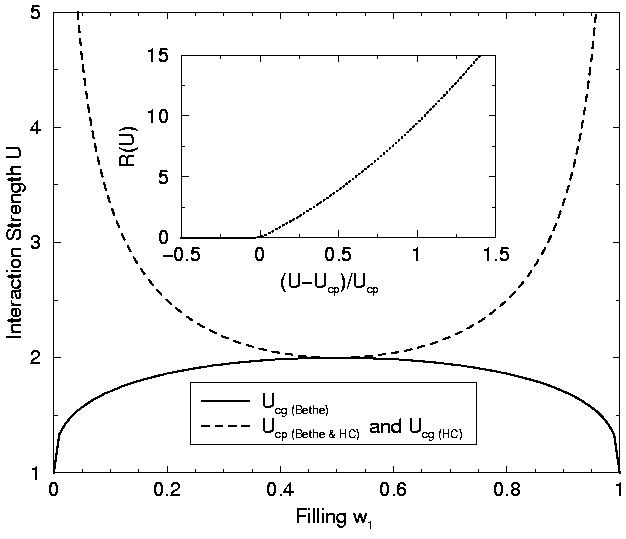 D. O. Demchencko, A. V. Joura, and
J. K. Freericks,
Effect of particle-hole asymmetry on the Mott-Hubbard metal-insulator transition
Phys. Rev. Lett. 92, 216401--1-4 (2004).
D. O. Demchencko, A. V. Joura, and
J. K. Freericks,
Effect of particle-hole asymmetry on the Mott-Hubbard metal-insulator transition
Phys. Rev. Lett. 92, 216401--1-4 (2004).
This work shows that the metal-insulator transition in dynamical mean
field theory is not always governed by the creation of a pole in
the self energy at the transition.l On systems with a finite bandwidth,
the MIT usually occurs before a pole forms, and the model does not have
any significant change in its properties when a pole subsequenctly forms
at a larger interaction strength.
-
A. M. Shvaika and
J. K. Freericks,
Equivalence of the Falicov-Kimball and Brandt-Mielsch forms for the free energy
of the infinite-dimensional Falicov-Kimball model,
Phys. Rev. B 67, 153103--1-3 (2003).
- This work is almost a textbook derivation of the equivalence of two
apparently different ways to calculate the free energy of the Falicov-Kimball
model.
-
R. Lemanski,
J.K. Freericks and G. Banach,
Stripe phases in the
two-dimensional Falicov-Kimball model,
Phys. Rev. Lett. 89 196403-1--4 (2002).
Here we show how stripe-like phases naturally arise in the two-dimensional
Falicov-Kimball model as the system changes from a checkerboard pattern
at half filling to a segregated system at low filling.
-
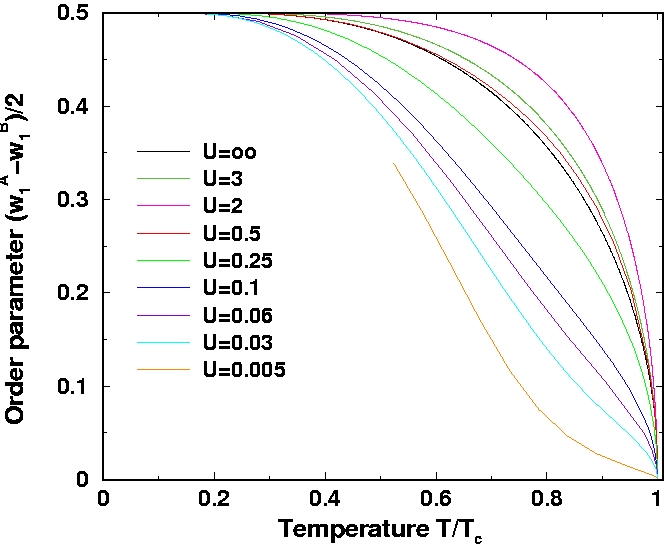 J. K. Freericks,
E. H. Lieb,
and D. Ueltschi,
Phase separation due to quantum mechanical
correlations, Phys. Rev. Lett. 88, 106401--1-4 (2002).
J. K. Freericks,
E. H. Lieb,
and D. Ueltschi,
Phase separation due to quantum mechanical
correlations, Phys. Rev. Lett. 88, 106401--1-4 (2002).
J. K. Freericks,
E. H. Lieb,
and D. Ueltschi,
Segregation in the
Falicov-Kimball model, Commun. Math. Phys. 227, 243--279 (2002).
In this work, we solved a long-standing problem that proved that the
Falicov-Kimball model always phase separates when the interaction strength is
large enough on any lattice in any dimension.
-
Ling Chen, B. A. Jones, and
J. K. Freericks,
Charge-density-wave order parameter of the Falicov-Kimball model
in infinite dimensions, Phys. Rev. B 68, 153102--1-4 (2003).
Ch. Gruber, N. Macris, Ph. Royer, and
J. K. Freericks,
Higher period ordered phases on the Bethe lattice,
Phys. Rev. B. 63, 165111-1--11 (2001).
We examine the charge-density wave ordered phase of the Falicov-Kimball
model. In the 2003 paper, we examine the order parameter as a function of
temperature, and see that it has an anomalous shape for weak coupling.
In the 2001 paper, we explicitly show how to generate a period-three phase on an
infinite-coordination Bethe lattice. Surprisingly, these phases are
stable only at very low temperature, and typically have first-order
phase transitions.
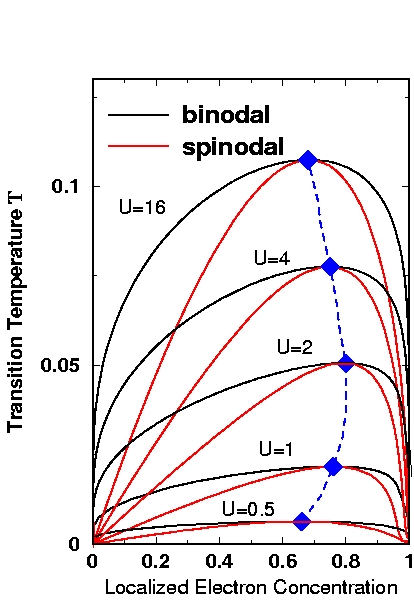
- J. K. Freericks
and P. Miller,
Dynamical charge susceptibility of the spinless Falicov-Kimball model,
Phys. Rev. B 62, 10022--10032 (2000).
We use Kadanoff-Baym theory to derive the frequency dependent
charge susceptibility for the Falicov-Kimball model, which is one
of the few many-body systems that one can exactly solve for a dynamical
susceptibility. These results were used heavily in deriving Raman
scattering behavior for nontrivial symmetry sectors.
-
B.M. Letfulov and
J. K. Freericks,
Phase separation in the combined
Falicov-Kimball and static Holstein model, Phys. Rev. B 66,
033102-1--4 (2002).
J. K. Freericks
and R. Lemanski,
Segregation and charge-density-wave order in the spinless
Falicov-Kimball model, Phys. Rev. B 61 13438--13444 (2000).
J. K. Freericks,
Ch. Gruber, and N. Macris,
Phase separation and the segregation principle in
the infinite-U spinless Falicov-Kimball model,
Phys. Rev. B 60 1617--1626 (1999).
J. K. Freericks,
Ch. Gruber, and N. Macris,
Phase separation in the binary-alloy
problem: the one-dimensional spinless Falicov-Kimball model,
Phys. Rev. B 53, 16189-16196 (1996).
J. K. Freericks,
Local approximation to the spinless Falicov-Kimball
model, Phys. Rev. B 48, 14797-14801 (1993).
J. K. Freericks,
Spinless Falicov-Kimball model (annealed
binary alloy) from large to small dimensions, Phys. Rev. B 47,
9263-9272 (1993).
J. K. Freericks
and L. M. Falicov,
Two-state one-dimensional
spinless Fermi gas, Phys. Rev. B 41, 2163-2172 (1990).
These series of papers examine phase separation and charge-density-wave
order in the Falicov-Kimball model. Results range from numerical
calculations on one-dimensional or infinite-dimensional systems,
to rigorous results for small or large coupling strength. One of the
interesting results coming from this work is the strong tendency for
electron repulsion to favor phase separation, which has been seen in the
charge-stripe phase of the cuprate materials.
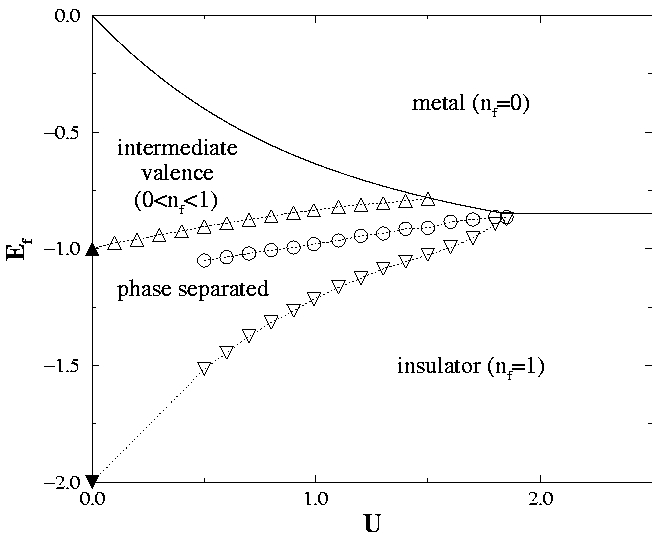
- Woonki Chung
and J. K. Freericks,
Competition between phase separation and ``classical'' intermediate
valence in an exactly solved model, Phys. Rev. Lett. 84, 2461--2464
(2000).
Woonki Chung
and J. K. Freericks,
Charge-transfer metal-insulator transitions in the spin-one-half Falicov-Kimball
model, Phys. Rev. B 57 11955--11961 (1998).
J. K. Freericks
and L. M. Falicov,
Thermodynamic model of the
insulator-metal transition in nickel iodide, Phys. Rev. B 45,
1896-1899 (1992).
These publications examine metal-insulator transitions and
intermediate-valence behavior, providing an exact solution that
proves first-order transitions exist in the Falicov-Kimball model.
In addition, we found that phase separation or a direct metal-insulator
transition usually preclude intermediate-valence behavior over a
wide range of parameter space.
-
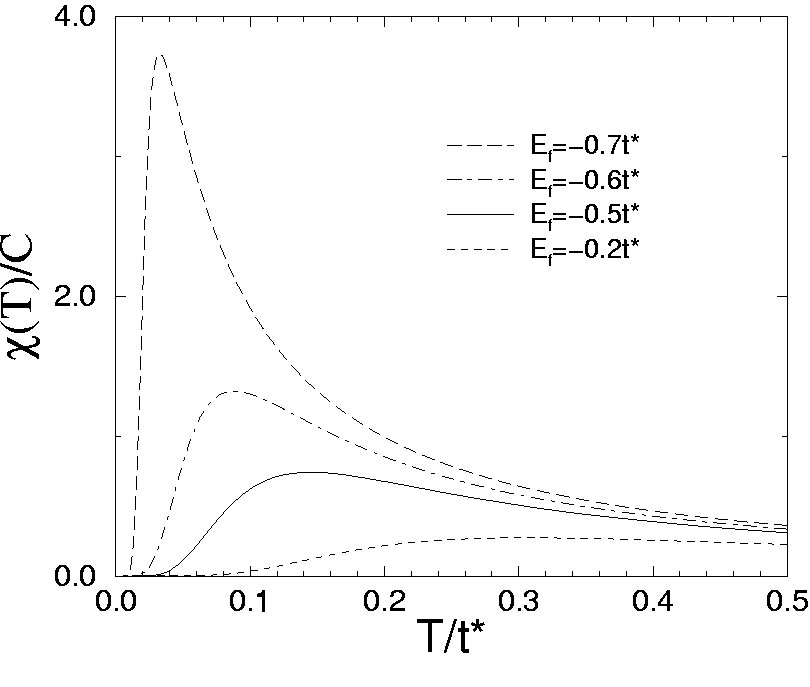 V. Zlatic' and
J. K. Freericks,
Describing the valence-change transition
by the DMFT solution of the Falicov-Kimball model,
(Proceedings of the NATO ARW on strongly correlated electrons, Hvar, Croatia)
to be published (Kluwer).
V. Zlatic' and
J. K. Freericks,
Describing the valence-change transition
by the DMFT solution of the Falicov-Kimball model,
(Proceedings of the NATO ARW on strongly correlated electrons, Hvar, Croatia)
to be published (Kluwer).
V. Zlatic' and
J. K. Freericks,
DMFT solution of the Falicov-Kimball model with an internal structure,
(Proceedings of the Strongly Correlated Electrons conference, Krakow, Poland)
Acta Physica Polonica B 34, 931--944 (2003).
J. K. Freericks
and V. Zlatic',
Application of the multicomponent
Falicov-Kimball model to intermediate-valence materials: YbInCu4 and
EuNi2(Si1-xGex)2,
(Proceedings of the Physics of Magnetism, Poznan, Poland),
physica status solidi (b) 236, 265--271 (2003).
V. Zlatic' and
J. K. Freericks,
Theory of valence transitions in Ytterbium and Europium intermetallics,
(Proceedings of the XIIth school of modern physics on
phase transitions and critical phenomena, Ladek Zrdoj, Poland)
Acta Physica Polonica B 32, 3253--3266 (2001).
V. Zlatic' and
J. K. Freericks,
Theory of valence transitions in ytterbium-based compounds,
in Open Problems in Strongly Correlated
Electron Systems, edited by J. Bonca, P. Prelovsek, A. Ramsak,
and S. Sarkar, (Kluwer, Dordrecht, 2001) p. 371--380 [NATO Science Series, II.
Mathematics, Physics, and Chemistry--Vol. 15] (Proceedings of NATO ARW
conference, Bled, Slovenia, 2001).
J. K. Freericks
and V. Zlatic',
Anomalous magnetic response of the spin-one-half
Falicov-Kimball model, Phys. Rev. B 58 322--329 (1998).
Here we examine the anomalous properties of the YbInCu4 system.
We find that this material, which undergoes a finite temperature intermediate
valence phase transition, is described well by the Falicov-Kimball
model at high temperatures, where a metal-insulator transition drives
the electronic density of states down, so hybridization effects are
not very important. As the temperature is lowered, the system
is described better by a periodic Anderson model. Our initial
interpretation of the data, in terms of ill-placed and properly placed
Yb atoms, turned out not to be borne out by experiment.
Hubbard Model
Periodic Anderson Model

- A. N. Tahvildar-Zadeh,
M. Jarrell, Th. Pruschke,
and J. K. Freericks,
Evidence for exhaustion in the conductivity of the
infinite-dimensional periodic Anderson model, Phys. Rev. B 60,
10782--10787 (1999).
A. N. Tahvildar-Zadeh,
M. Jarrell,
and J. K. Freericks,
Low-temperature coherence in the periodic Anderson model:
Predictions for photoemission of heavy Fermions, Phys. Rev. Lett.
80 5168--5171 (1998).
A. N. Tahvildar-Zadeh,
M. Jarrell,
and J. K. Freericks,
Protracted screening in the periodic Anderson model, Phys. Rev. B
55, 3332-3335 (1997) (Rapid Communication)
This series of papers covers phenomena related to exhaustion physics
in the periodic Anderson model. This occurs when there are fewer
conduction electrons than f-electrons to be able to screen all of the
local moments except as a collective process. As a result, there are
interesting predictions about what should be seen in photoemission and
optical conductivity measurements, which agree with that observed for
some heavy-fermion or intermediate-valence materials.
Holstein Model
-
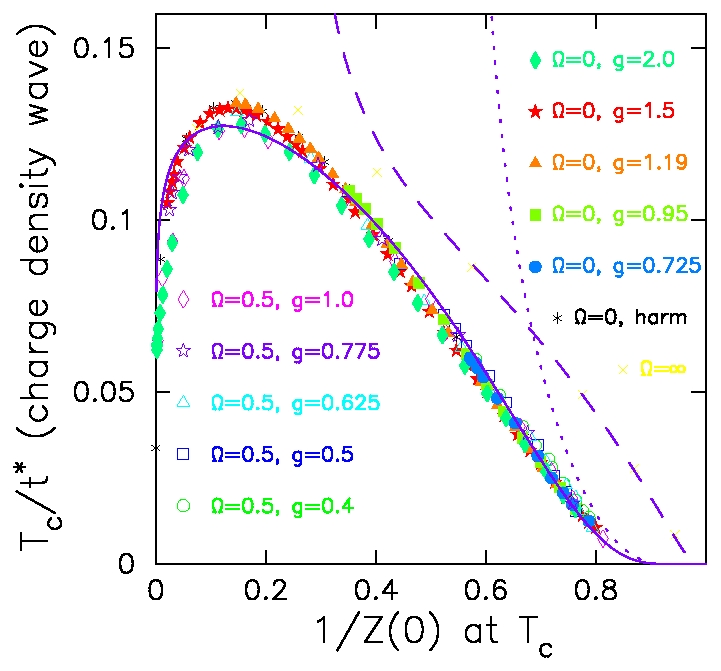 J. K. Freericks
and V. Zlatic',
Gap ratio in anharmonic charge-density-wave systems,
Phys. Rev. B 64, 073109 (2001).
J. K. Freericks
and V. Zlatic',
Gap ratio in anharmonic charge-density-wave systems,
Phys. Rev. B 64, 073109 (2001).
J. K. Freericks,
V. Zlatic',
and M. Jarrell,
Approximate scaling relation for the anharmonic electron-phonon problem,
Phys. Rev. B 61, R838--841 (2000) (Rapid Communication).
J. K. Freericks,
M. Jarrell,
and G. D. Mahan,
The anharmonic electron-phonon problem,
Phys. Rev. Lett. 77, 4588-4591 (1996);
Erratum: Phys. Rev. Lett. 79, 1783 (1997).
J. K. Freericks
and G. D. Mahan,
Strong-coupling expansions for the anharmonic Holstein
model and for the Holstein-Hubbard model, Phys. Rev. B 54,
9372-9384 (1996);
Erratum: Phys. Rev. B 56, 11321-11325 (1997).
Here we examine differences that arise when anharmonic phonons interact
with electrons (as one would normally expect to occur in a real material
where the phonons are not harmonic since the lattice expands when
heated). Surprisingly, we find scaling behavior of our results, which
say that once one maps the anharmonic system onto an equivalent harmonic
system, then both the single-particle and the two-particle
properties are essentially the same for harmonic and anharmonic systems.
This is surprising, because it requires scaling behavior for the
transition temperature and the charge-density-wave gap at zero
temperature, which one wouldn't naively expect to scale exactly the
same way with anharmonicity.
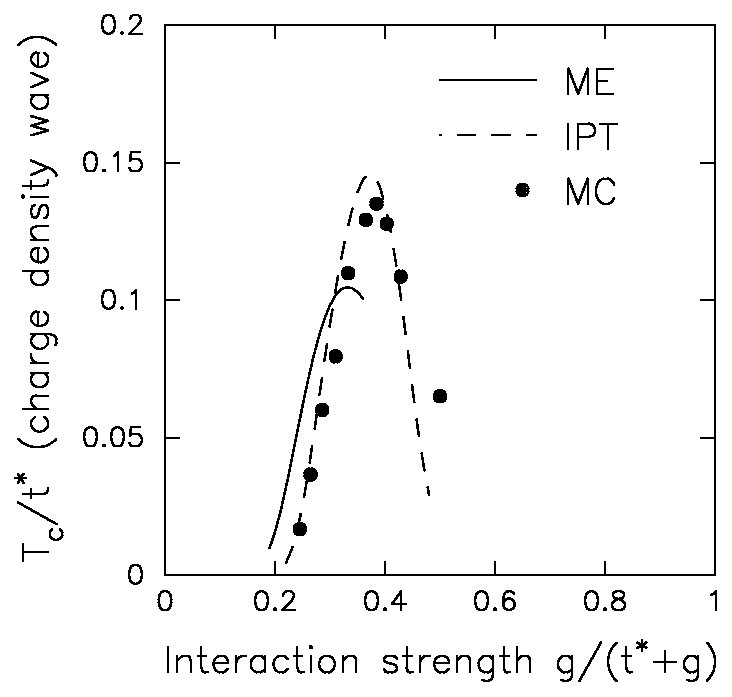
- P. Miller,
J. K. Freericks,
and
E. J. Nicol,
Possible experimentally observable effects of vertex corrections in
superconductors, Phys. Rev. B 58, 14498--14510 (1998).
J. K. Freericks,
V. Zlatic', Woonki Chung,
and M. Jarrell,
Vertex-corrected perturbation theory for the electron-phonon problem
with non-constant density of states, Phys. Rev. B 58, 11613--11623
(1998).
J. K. Freericks
and M. Jarrell,
Iterated perturbation theory for
the attractive Holstein and Hubbard models, Phys. Rev. B 50
, 6939-6953 (1994).
J. K. Freericks,
Conserving approximations for the attractive
Holstein and Hubbard models, Phys. Rev. B 50, 403-417
(1994).
J. K. Freericks
and
D. J. Scalap
ino,
Weak-coupling expansions for
the attractive Holstein and Hubbard models, Phys. Rev. B 49,
6368-6371 (1994).
E. J. Nicol and
J. K. Freericks,
Vertex corrections to the theory
of superconductivity, Physica C 235-240, 2379-2380
(1994).
J. K. Freericks,
Strong-coupling expansions for the attractive
Holstein and Hubbard models, Phys. Rev. B 48, 3881-3891
(1993).
This is a series of weak and strong-coupling perturbation series expansions
for the electron-phonon problem. We find that in the strong-coupling
limit, the simple perturbative expansions are quite accurate when one is
in the bipolaronic (pre-formed pair) regime. On the weak-coupling
side, however, we find that virtually nothing allows you to accurately
extend the conventional perturbation theory beyond a coupling strength
on the order of one. We do predict, that the best way to look for
effects of vertex corrections in a real material is through the
isotope effect, which will have very different behavior if vertex
corrections are important.

- J. K. Freericks
and M. Jarrell,
Competition between electron-phonon attraction and weak Coulomb
repulsion, Phys. Rev. Lett., 75, 2570-2573 (1995).
J. K. Freericks,
M. Jarrell, and
D. J. Scalapino,
The electron-phonon problem in infinite dimensions, Europhys. Lett.
25, 37-42 (1994).
J. K. Freericks
and M. Jarrell,
Simulation of the electron-phonon
interaction in infinite dimensions, in Computer Simulations in
Condensed Matter Physics VII,
edited by D. P. Landau, K. K. Mon, and H.-B.
Schuttler (Springer-Verlag, Heidelberg, Berlin, 1994).
J. K. Freericks,
M. Jarrell, and
D. J. Scalapino,
Holstein model
in infinite dimensions,
Phys. Rev. B 48, 6302-6314 (1993).
This is a series of quantum Monte Carlo simulations investigating
properties of harmonic electron-phonon systems and examining
the regions of stability for charge-density-wave ordered phases versus
superconductivity. A number of interesting results came out of this
work ranging from unexpected robustness of the charge-density-wave order
at half filling to a Coulomb repulsion, a change in character of the
ground state from one that orders and pairs at Tc to one that has
a preformed pair that condenses at a lower temperature, and
a large reduction in transition temperatures due to vertex corrections.
- J. K. Freericks
and E. H. Lieb,
The ground state of a general
electron-phonon Hamiltonian is a spin singlet, Phys. Rev. B 51
, 2812-2821 (1995).
In this work, we show that the ground state of an electron-phonon
system, with a wide range of different (nonlinear) couplings always
contains a spin-singlet state. For a class of models (including the
Holstein model), we show that the ground state is unique, and hence must be
a spin singlet. One consequence of the uniqueness is that there is
no self-trapping transition of a polaron, rather it is a smooth
(albeit very rapid) transition from a delocalized to a localized
``quasiparticle.''
Bose Hubbard Model
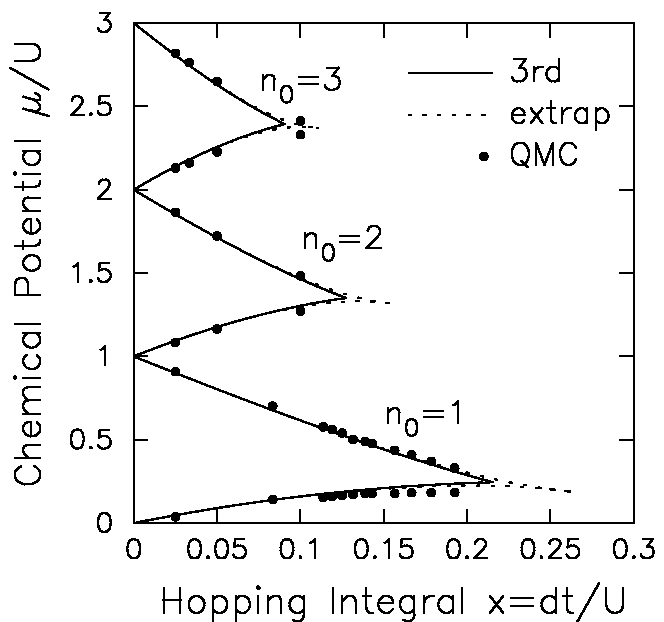
- M. Niemeyer,
J. K. Freericks,
and H. Monien,
Strong-coupling perturbation theory for the two-dimensional Bose-Hubbard
model in a magnetic field,
Phys. Rev. B 60 2357--2362 (1999).
J. K. Freericks
and H. Monien,
Strong-coupling expansions for the pure and disordered Bose
Hubbard model, Phys. Rev. B 53, 2691-2700 (1996).
J. K. Freericks
and H. Monien,
Phase diagram of the Bose Hubbard
model, Europhys. Lett. 26, 545-550 (1994).
H. Monien and
J. K. Freericks,
Phase diagram of the Bose Hubbard
model, in Strongly Correlated Electronic Materials Los Alamos Symposium
1993, edited by K. Bedell, E. Abrahams, A. Balatsky, D. Meltzer, and
Z. Wang (Addison-Wesley, New York, 1994).
This work focuses on using strong-coupling perturbation theory to
determine the phase boundary of the bose Hubbard model, which can be
viewed as a model for disordered superconductivity, where there is
local pairing, but no global phase coherence. What is surprising in this
work is that low-order perturbation theory can rival the accuracy of
complicated quantum Monte Carlo simulations, and that one can determine
phase boundaries in the disordered case much more accurately, because one
can explicitly take into account so-called rare regions. Most of the results
of this work was verified either numerically, by performing expansions to
high order, or experimentally (by Mooij's group) on microfabricated
Josephson junction array experiments.
Small Cluster Calculations
- J. K. Freericks
and L. M. Falicov,
Heavy-fermion systems in magnetic
fields: the metamagnetic transition, Phys. Rev. B 46,
874-879 (1992).
L. M. Falicov and
J. K. Freericks,
Electronic Structure of Highly
Correlated Systems, in Condensed Matter Theories, Vol. 8, edited by
L. Blum and F. Bary Malik (Plenum Press, 1992).
J. K. Freericks,
L. M. Falicov, and D. S. Rokhsar,
Exact solutions
of frustrated ordinary and chiral eight-site Hubbard models, Phys. Rev. B
44, 1458-1475 (1991).
J. K. Freericks
and L. M. Falicov,
Exact many-body solution of the
periodic-cluster t-t'-J model for cubic systems: ground-state
properties, Phys. Rev. B 42, 4960-4978 (1990).
This is work performed during my graduate-school days. We examined the
exact solution of a number of Hubbard-like models on small clusters.
Much interesting physics was discovered, especially about the
stability of magnetic phases, and metamagnetism, but I found the
finite-size effects were often too big to be able to make much
progress with this approach.
- J. K. Freericks
and L. M. Falicov, Enlarged symmetry groups of
finite-size clusters with periodic boundary conditions, Lett. Math. Phys.
22, 277-285 (1991).
J. K. Freericks
and L. M. Falicov,
Hidden symmetries of finite-size
clusters with periodic boundary conditions, Phys. Rev. B 44,
2895-2904 (1991).
These results, that finite-size clusters have extra symmetries, is
something that I found to be fascinating when I discovered it to occur
in a general case. Unfortunately, since the extra symmetry leads to
``accidental'' degeneracies in the many-body spectrum, this result
also showed that until the cluster is large enough, finite-size effects
can be very strong, and very difficult to disentangle, by any simple
analysis of the calculated results.
Jim Freericks, Professor of Physics







 J. K. Freericks,
T. P. Devereaux, and
R. Bulla,
B1g Raman scattering through a quantum critical point,
(Proceedings of the XIIth school of modern physics on
phase transitions and critical phenomena, Ladek Zrdoj, Poland)
Acta Physica Polonica B 32, 3219--3232 (2001).
J. K. Freericks,
T. P. Devereaux, and
R. Bulla,
B1g Raman scattering through a quantum critical point,
(Proceedings of the XIIth school of modern physics on
phase transitions and critical phenomena, Ladek Zrdoj, Poland)
Acta Physica Polonica B 32, 3219--3232 (2001).

 A. V. Joura, D. O. Demchencko, and
A. V. Joura, D. O. Demchencko, and

 D. O. Demchencko, A. V. Joura, and
D. O. Demchencko, A. V. Joura, and




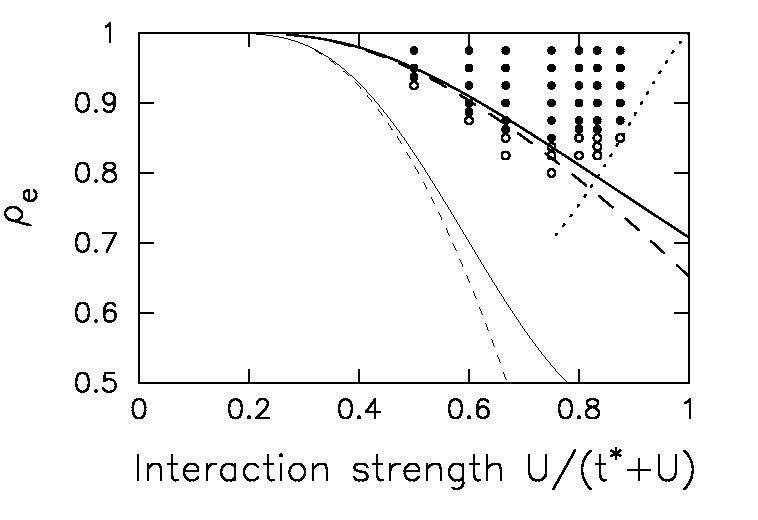 A. N. Tahvildar-Zadeh,
A. N. Tahvildar-Zadeh,




